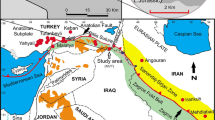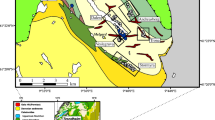Abstract
Several important mineral deposits of Sn, Zn, Cu, Pb, and other metals associated with Devonian sediments and Yanshanian (Cretaceous) granitic rocks are known in the Dachang district (Guangxi). Early genetic hypotheses related the origin of the deposits entirely to the Yanshanian granites. Recently, it was suggested that in Devonian times an earlier syngenetic metal concentration may have occurred, later overprinted by the Yanshanian metallogeny. This contribution is aimed at placing constraints on the physicochemical conditions during the Yanshanian ore formation-remobilization by studying the sulfide chemistry (arsenopyrite, sphalerite, stannite) and fluid inclusion data on the two major deposits in the area, i.e., the polymetallic cassiterite deposit of Changpo and the Zn-Cu skarn deposit of Lamo. Sphalerite and arsenopyrite are quite abundant in both deposits; stannite is minor, but fairly widespread at Changpo, and quite rare at Lamo. They are accompanied by pyrite, pyrrhotite, galena, chalcopyrite, cassiterite, fluorite, and a large variety of other sulfides and sulfosalts. The main compositional data for sphalerite and arsenopyrite are summarized as follows:
Changpo: arsenopyrite associated with pyrrhotite 31.4–36.1 at% As; Associated with pyrite 31.9–33.1 at% As; sphalerite associated with pyrrhotite 18.3–22.2 mol% FeS; associated with pyrite 10.6–18.6 mol% FeS.
Lamo: arsenopyrite associated with pyrrhotite 32.9–35.3 at% As; associated with pyrite 30.3–31.7 at% As; sphalerite associated with pyrrhotite, 17.2–24.4 mol% FeS; associated with pyrite 4.2–19.6 mol% FeS.
Partitioning of Fe and Zn between coexisting sphalerite and stannite from Changpo indicates temperatures of 300°–350°C. For Lamo, the following fluid inclusion data are available: fluorite, salinities of ∼0–9.5 equiv. wt% NaCl, and homogenization temperatures between 160°C and 250°C; quartz, moderate salinities (∼0–4.6 equiv. wt% NaCl), and homogenization temperatures of 208°–260°C. Combining the mineralogical evidence with the compositional and fluid inclusion data, it is suggested that the evolution of the environment during the Yanshanian event was characterized by the following parameters: pressure was relatively low (on the order of 1–1.5 kb); temperature may have been as high as 500°C during deposition of the As-richest arsenopyrites, but eventually dropped below 200°–250°C in the latest stages; with an increase in sulfur activity and/or the decrease in temperature pyrrhotite was no longer stable in the latest stages of mineralization.
Similar content being viewed by others
References
Colby, J.W.: MAGIC IV. A computer program for quantitative electron microprobe analysis. Bell Telephone Lab., Allentown, Pa. (1967)
Corsini, F., Tanelli, G.: Un contributo al “problema della stannite”: la “stannite” dei giacimenti a Sn-Cu-Zn(Ag) di Dachang, Guangxi, Repubblica Popolare Cinese. Rendiconti Soc. Ital. Mineral. Petrol. 39:669–675 (1984)
Huang, M., Chen, Y., Tang, S., Li, X., Chen, K., Weng, W.: A study of sulfosalt mineral series and their paragenetic association in the Changpo cassiterite-sulfide deposit, Zhuang autonomous region of Guangxi. Bull. Inst. Mineral Dep. Chinese Acad. Geol. Sci. 15:110–145 (1985) — in Chinese with English abstract
Hutchison, M.N., Scott, S.D.: Sphalerite geobarometry in the Cu-Fe-Zn-S system. Econ. Geol. 76:143–153 (1981)
Kissin, S.A., Scott, S.D.: Phase relations involving pyrrhotite below 350°C. Econ. Geol. 77:1739–1754 (1982)
Kretschmar, U., Scott, S.D.: Phase relations involving arsenopyrite in the system Fe-As-S and their application. Can. Mineral. 14:364–386 (1976)
Lei, L.: A tentative discussion on the origin of the Changpo tinpolymetallic deposit, Dachang ore field. Mineral Deposits (Beijing) 5 (3):87–96 (1986) — in Chinese with English abstract
Ma, L.: Geochemical features and mineralization of Dachang-Mangchang granites, Nandan, Guangxi. Abstr. Internat. Symp. on Petrogenesis and Mineralization of Granitoids, Guangzhou, p. 209–210 (1987)
Moelo, Y., Marcoux, E., Makovicky, E., Karup-Mñller, S., Legendre, O.: Homologues de la lillianite (gustavite, vikingite, heyrovskite riche en Ag et Bi ...) de l'indice à W-As-(Pb,Bi,Ag) de La Roche-Balue (Loire atlantique, France). Bull. Minéral. 110:43–64 (1987)
Moh, G.H., Li, J.: Paragenesis and genesis of the tin-bearing sulfide ores in Dachang/China. Neues Jb. Mineral. Abh. 153:267–272 (1986)
Nakamura, Y., Shima, H.: Fe and Zn partitioning between sphalerite and stannite. Abstr. Joint Mtg. Soc. Mining Geol. Japan, Assoc. Mineral. Petrol. Econ. Geol. and Mineral. Soc. Japan, A-8 (1982) – in Japanese
Nekrasov, I.J., Sorokin, V.I., Osadchii, E.G.: Fe and Zn partitioning between stannite and sphalerite and its application in geothermometry. In: Origin and distribution of the elements, L.H. Ahrens ed., Pergamon Press, Oxford, 739–742 (1979)
Potter, R.W., II: Pressure corrections for fluid-inclusion homogenization temperatures based on the volumetric properties of the system NaCl-H2O. J. Res. U.S. Geol. Surv. 5:603–607 (1977)
Roedder, E.: Fluid inclusions. Mineral. Soc. America, Reviews in Mineralogy, v. 12, 644 pp. (1984)
Scott, S.D.: Chemical behaviour of sphalerite and arsenopyrite in hydrothermal and metamorphic environments. Mineral. Mag. 47:427–435 (1983)
Scott, S.D., Kissin, S.A.: Sphalerite composition in the Zn-Fe-S system below 300°C. Econ. Geol. 68:475–479 (1973)
Sharp, Z.D., Essene, E.J., Kelly, W.C.: A re-examination of the arsenopyrite geothermometer: pressure considerations and applications to natural assemblages. Can. Mineral. 23:517–534 (1985)
Shimizu, M., Shikazono, N.: Iron and zinc partitioning between coexisting stannite and sphalerite: a possible indicator of temperature and sulfur fugacity. Mineral. Deposita 20:314–320 (1985)
Tanelli, G., Lattanzi, P.: The cassiterite-polymetallic sulfide deposits of Dachang (Guangxi, People's Republic of China). Mineral. Deposita 20:102–106 (1985)
Tu, G., Zhao, Z.: Mineralizations relevant to granitoids as exemplified by Chinese ore deposits. Abstr. Internat. Symp. on Petrogenesis and Mineralization of Granitoides, Guangzhou, p. 286–287 (1987)
Xu, K., Zhou, H., Zhu, J., Ye, J.: Petrological characteristics and ore-forming background of some granites related to cassiteritesulfide ore deposits in South China. Abstr. Internat. Symp. on Petrogenesis and Mineralization of Granitoids, Guangzhou, p. 371–372 (1987)
Yan, Y., and Ye, X.: Genetic relations between granite characteristics and cassiterite polymetallic sulfide deposition, Dachang ore field, Guangxi. Internat. Symp. on Petrogenesis and Mineralization of Granitoids, Guangzhou, p. 385 (1987)
Zhang, Z., Li, X.: Studies on mineralization and composition of DC ore field, Guangxi, China. Geochimica, 74–86 (1981) — in Chinese with English abstract
Author information
Authors and Affiliations
Rights and permissions
About this article
Cite this article
Lattanzi, P., Corazza, M., Corsini, F. et al. Sulfide mineralogy in the polymetallic cassiterite deposits of Dachang, P.R. China. Mineral. Deposita 24, 141–147 (1989). https://doi.org/10.1007/BF00206318
Received:
Accepted:
Issue Date:
DOI: https://doi.org/10.1007/BF00206318




